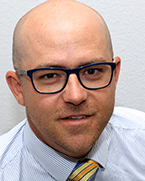FETC 2017: Q&A with Mike Meechin on Integrating Tech into the Classroom
For students at Poinciana High School in central Florida, interacting with technology to support learning begins when they wake up.
Mike Meechin, an innovative educator, speaker, blogger and principal at Poinciana High, gave the second keynote at the 37th National Future of Education Technology Conference.
In his speech titled “Breaking Down Barriers to High-Impact Instruction,” Meechin told the audience how technology can help solve issues that many schools face.
EdTech caught up with Meechin after his speech to talk about how his school is proof of the power of tech in education.
 EDTECH: How can K–12 educators and administrators be better integrating technology?
EDTECH: How can K–12 educators and administrators be better integrating technology?
MEECHIN: You need to look at what your school needs. You really need to know where you are going as a team in order to accomplish tech integration. It depends on what your school’s barriers are, but technology can be a very powerful weapon in breaking them down. The mistake a lot of school districts make is that they integrate tech and look it at it on the surface level only. If they don’t actually use it to enhance learning, it’s pointless.
EDTECH: How has Poinciana High School integrated technology to solve problems and enhance learning?
MEECHIN: One of our biggest barriers is that we have a lot of students with low attendance. We serve a population of students that are at-risk and low income. Some of our parents are working at least two jobs, and our students don’t have anyone at home when they wake up for school.
With a tool like the app Remind, we can send them text messages every morning that serve as a wake-up call. They are inspirational messages that let the students how excited we are to see them that day. Students in that reminder group have, on average, increased their attendance rate by 60 percent.
We’ve also taken advantage of a partnership between Khan Academy and College Board that provides free SAT practices. Students can link their PSAT scores and a customized test prep will be created for them. We just finished with a pilot group of 20 students where we saw an average increase of 120 points.
At our school, we’ve got students that come in reading below their grade level. This is not an area we’ve been able to get traction on until now.
EDTECH: What do you think is stopping schools from integrating technology like this regularly?
MEECHIN: It’s a combination of a lack of professional development and other things. It might be that a teacher has been teaching for 30 years and the technology is just moving too fast. It could be a comfort level thing. But you also just have to have the pedagogy before you have technology.
I can put a cart of tablets in your classroom, but that doesn’t make you an innovative teacher. It won’t make the lesson you are going to do innovative.
EDTECH: How has Poinciana addressed this?
MEECHIN: We use the same model for everything, whether it is technology related or not. When we send staff out for professional development, we talk about the return on that investment. If we send you out and we invest in your PD, we expect a return.
At our school that means strategy walks, where other teachers come into your classroom on their planning period and watch you use the new skills you learn.
EDTECH: How do you think technology has changed education today?
MEECHIN: Tech just gives us more options. I use a metaphor about Starbucks. They have thousands of possible flavors. Imagine if we take that same mindset and bring that into the classroom to give kids choice.









